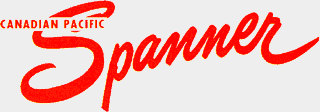 |
April-May, 1960
|
Keeping Up the Freight Fleet
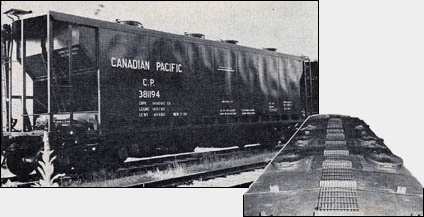
In 1959 the Canadian Pacific purchased 152 70-ton covered
hoppers cars of the type shown above. At right is shown the roof of a new car with its eight circular hatches for
loading purposes.
New Freight Units Provide Added Efficiency for Vital Aspect of Company's
Operations.
The unsung heroes of the transportation drama which is on stage 24 hours day and night, are the freight trains and
the individual units of freight equipment that make up these important revenue producers. For it is indeed these
trains, carrying as they do the bulk of the country's industrial and agricultural wealth to market that in turn
"produce" the bulk earnings that meet payrolls and provide work for our vast army of railroaders.
| |
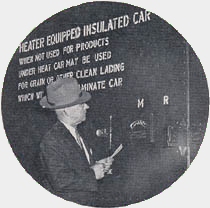
V.G. Smart, assistant chief of transportation, Montreal, looks over
one of the new insulated box cars.
|
As these modern high-iron caravans wind their way across the prairies and over the mountains, it is
likely that little attention is paid to the individual units by the onlooker; they certainly do not draw the same
attention on the front pages as a new rocket or missile.
But from a railroading point of view freight equipment is just as important for the purpose it serves - that is, to
move the shipper's goods in the best possible way and in the most modern unit, whether it be a new
"piggyback" flat car designed and engineered with specific intent and efficiency or a refrigerator car with
its complicated heating and cooling systems.
Freight equipment doesn't just grow "like Topsy". It's designed with utmost care and after exhaustive
research in all fields of transportation. Consideration must be given to unloading, riding qualities, capacity,
"safety in transit" features, and a myriad of factors that only skilled railway equipment engineers and
freight experts - to say nothing of the shipper who pays the freight - would take into consideration.
Freight equipment has been a necessary - but an expensive annual bill in the company's books and a great deal of
money, study, and foresight, have gone into expanding and improving this section of the Company's capital property.
In 1959, for instance, the Company purchased 1,966 units of freight equipment, while 1,500 units have been ordered
for 1960. box cars have accounted for the largest number of units, these including 50-ton standard box
cars, insulated box cars, and auto box cars.
Total new freight equipment purchased by the Company in 1959 consisted of 300 piggyback flat cars, 500
50-ton box cars, 500 50-ton auto box cars, 152 70-ton covered hopper cars, 14
air dump cars, and 500 insulated box cars.
New freight equipment ordered for 1960 is made up of 200 flat cars, 100 flat cars (with bulkheads), 1,000 box cars,
and 200 piggyback flat cars. Photos and dimensions of this equipment are shown below:
Insulated Box Car
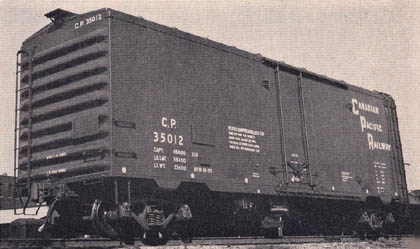
One of the 500 new insulated box cars
purchased by the Company in 1959. It is basically a standard box car, though insulation has been added.
Series: 35001 - 35500
Inside length: 39' - 7 1/2"
Width: 8' - 9 1/2"
Height: 9' - 8 3/8"
Cubic feet: 3,377
Capacity: 115,000 lbs
Basically a standard box car but insulated, having two independent heating systems. Equipped with plug doors
6' wide clear opening by 8' - 11 7/8" high.
|
Piggyback Flat Car
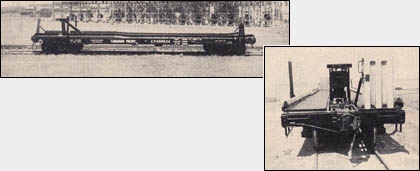
In 1959 the Company purchased 300
piggyback flat cars of the type shown here. This year the piggyback fleet will be augmented by 200 more flat
cars of the same dimensions as those purchased in 1959. The new car above has been re-numbered to
conform to the current series.
Series: 503302 - 503601
Length over deck: 46' - 0"
Width: 8' - 5 1/2"
Deck Height raised portion: 3' - 8 3/4"
Deck Height depressed portion 3' - 5 3/4"
Capacity: 66,000 lbs
Equipped with roller bearing trucks and one ACF hitch for securing trailer.
|
Auto Box Car
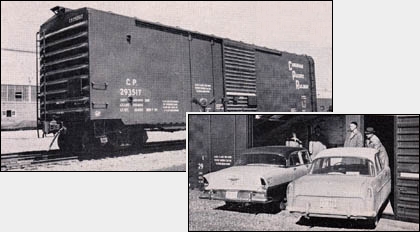
One of the 500 50-ton auto box
cars purchased by the Canadian Pacific in 1959 is seen here. The car's 16-ft. wide doors permit
two automobiles to enter side by side. The car can accommodate four autos. Grain, plywood, bundled lumber, and
other high class commodities can also be handled by this multi-purpose car.
Series: 293435 - 293934
Inside length: 50' - 6"
Inside Height: 10' - 6" with Evans auto device in use
Inside Height: 9' - 5" with Evans device in stored position on ceiling
Cubic feet: 4,360
Capacity: 105,000 lbs
Cars equipped with Evans device. Double doors each side 16' clear opening with height of 9' - 8". Equipped
with nailable steel flooring in doorway area only and type 16G2 loaders.
|
50-Ton Box Car
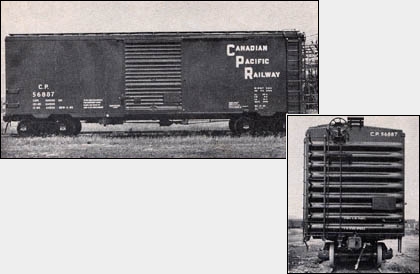
To keep pace with current
freight demands the Company in 1959 purchased 500 50-ton box cars of the type shown. New freight
equipment ordered for the current year includes 1,000 box cars of the same dimensions.
Series: 56525 - 57024
Inside length: 40' - 6"
Inside Width: 9' - 2"
Inside Height: 10' - 6"
Cubic feet: 3,900
Capacity: 125,000 lbs
Wide doors 8' clear opening. Nailable steel flooring at doorway areas.
|
Air Dump Car
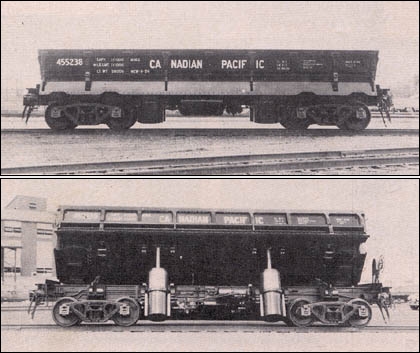
Fourteen air dump cars, on of which is
pictured here, were purchased by the Company in 1959.
Series: 455225 - 455238
Inside length: 30' - 6 1/2"
Inside Width: 10' - 1"
Inside Height: 3' - 0"
Capacity: 30 cubic yards
Load limit: 144,900 lbs
70-ton all steel car with dump doors.
|
This Canadian Pacific Spanner article
is copyright 1960 by the Canadian Pacific Railway and is reprinted here with their
permission. All photographs, logos, and trademarks are the property of the Canadian Pacific Railway
Company.
|